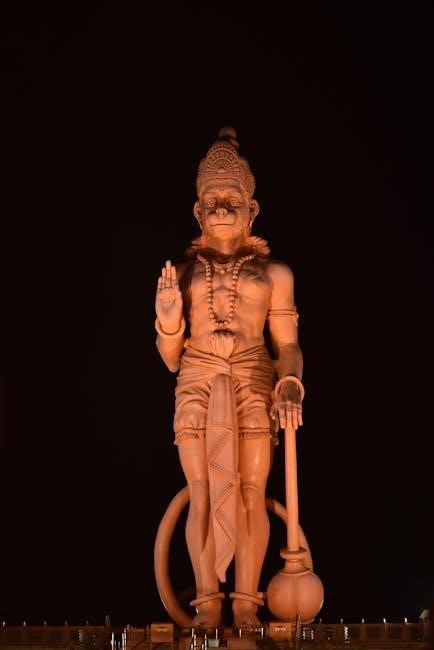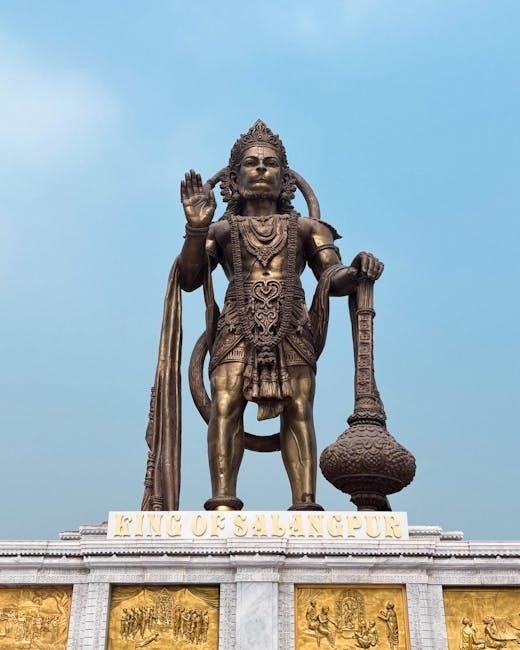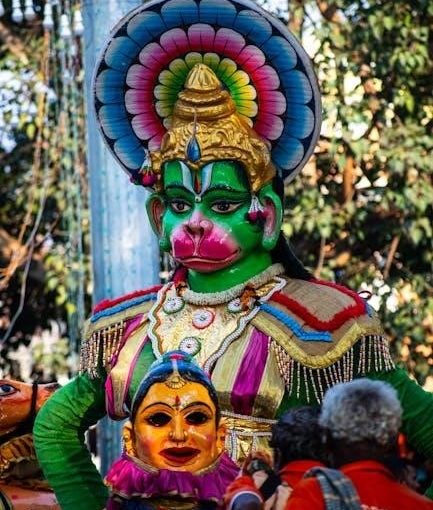The Shri Hanuman Chalisa is a revered Hindu devotional hymn composed by Tulsidas‚ extolling the virtues of Lord Hanuman‚ emphasizing his strength‚ loyalty‚ and devotion to Lord Rama.
Overview of the Hanuman Chalisa
The Hanuman Chalisa is a sacred Hindu devotional hymn comprising 40 verses‚ written by Tulsidas in the Awadhi dialect of Hindi. It glorifies Lord Hanuman‚ highlighting his immense strength‚ unwavering loyalty‚ and devotion to Lord Rama. Each verse reflects themes of spiritual growth‚ courage‚ and the triumph of good over evil. The hymn is widely recited for its calming effects‚ mental peace‚ and divine protection. Its popularity spans across cultures‚ with translations available in multiple languages. The Hanuman Chalisa is not only a literary masterpiece but also a powerful tool for spiritual enlightenment and emotional solace in everyday life.

Importance of the Hanuman Chalisa in Hindu Devotion
The Hanuman Chalisa holds profound significance in Hindu devotion‚ offering spiritual solace‚ mental peace‚ and protection from adversity. It is widely recited to invoke Lord Hanuman’s blessings‚ seeking courage‚ strength‚ and wisdom. The hymn is believed to dispel negative energies and bring prosperity‚ making it a cornerstone of daily worship for many devotees. Its verses‚ rich in devotion and philosophy‚ deepen the connection with Lord Rama and Hanuman‚ embodying the essence of surrender and faith. Recitation in temples and homes strengthens spiritual practices‚ fostering a sense of community and divine grace. Its universal appeal transcends linguistic barriers‚ uniting devotees worldwide in reverence and devotion.

History and Composition of the Hanuman Chalisa
The Hanuman Chalisa was composed by Tulsidas in the 16th century in the Awadhi dialect of Hindi. It consists of 40 verses praising Hanuman’s loyalty and strength‚ written in the chaupai meter‚ reflecting deep devotion to Lord Rama and Hanuman.
Tulsidas: The Author of the Hanuman Chalisa
Tulsidas‚ a 16th-century saint and poet‚ is the revered author of the Hanuman Chalisa. Born in Uttar Pradesh‚ he is celebrated for his literary masterpiece‚ the Ramcharitmanas‚ a Hindi retelling of the Ramayana. Tulsidas’s deep devotion to Lord Rama and Hanuman inspired him to compose the Chalisa‚ which reflects his spiritual connection and poetic brilliance. His works are considered divine and continue to be a cornerstone of Hindu devotion‚ emphasizing service‚ loyalty‚ and faith. Tulsidas’s legacy endures as a symbol of Bhakti‚ enriching the cultural and spiritual fabric of India.
Historical Significance and Origins
The Hanuman Chalisa holds profound historical and spiritual significance‚ tracing back to the 16th century. Composed by Tulsidas in the Awadhi dialect‚ it reflects the cultural and religious ethos of its time. The hymn’s origins are deeply rooted in Hindu mythology‚ particularly in the Ramayana‚ where Hanuman’s devotion to Rama is central. Its creation is often linked to Tulsidas’s divine inspiration and his quest to spread the teachings of Lord Rama. The Chalisa has since become a timeless prayer‚ recited across India and beyond‚ symbolizing strength‚ faith‚ and the triumph of good over evil.
Structure and Key Verses of the Hanuman Chalisa
The Hanuman Chalisa consists of 40 verses‚ beginning with a Doha and followed by chaupais‚ praising Hanuman’s devotion‚ strength‚ and service to Lord Rama‚ concluding with a final verse emphasizing its recitation benefits.
Understanding the 40 Verses and Their Meaning
The Hanuman Chalisa comprises 40 verses‚ each imbued with profound spiritual significance. It begins with a Doha‚ a couplet praising Guru‚ followed by 38 Chaupais‚ and concludes with a final verse. Each verse glorifies Hanuman’s devotion‚ strength‚ and selfless service to Lord Rama‚ while also highlighting his role as a protector and remover of obstacles. The hymn reflects themes of loyalty‚ courage‚ and divine grace‚ offering solace and empowerment to devotees. Recitation is believed to ward off negativity and bestow blessings‚ making it a revered practice in Hindu spirituality.
Key Verses and Their Spiritual Significance
Certain verses in the Hanuman Chalisa hold profound spiritual significance. The opening verse‚ “Shri Guru Charan Sarooja-Raj‚” seeks blessings from the Guru‚ setting a divine tone. Another pivotal verse‚ “Jai Hanuman Gyan Gun Sagar‚” praises Hanuman as an embodiment of wisdom and strength. The line “Rama Doota Atulit Bal Dhama” highlights his role as Rama’s messenger and his unparalleled power. A verse like “Bhima Roopa Dhikarhi Vinati” symbolizes humility and devotion‚ while “Hatha Vajra Tanu Dhari”‘ emphasizes his protective nature. These verses are believed to offer spiritual protection‚ calm the mind‚ and deepen devotion to Lord Rama and Hanuman.

Benefits of Reciting the Hanuman Chalisa
Reciting the Hanuman Chalisa offers spiritual growth‚ mental peace‚ and protection from adversity. It is believed to ward off negative energies and bring divine blessings.
Spiritual and Mental Health Benefits
Reciting the Hanuman Chalisa offers profound spiritual and mental health benefits. It fosters devotion‚ reduces stress‚ and enhances emotional well-being. The hymn’s verses bring mental peace‚ clarity‚ and courage‚ helping believers overcome life’s challenges. Regular recitation is believed to strengthen the mind‚ promote self-confidence‚ and provide protection from negativity. Many find solace in its rhythmic chanting‚ which calms the mind and uplifts the spirit. It is also considered a therapeutic practice‚ empowering individuals to face adversity with resilience. The Chalisa’s spiritual essence helps cultivate a deeper connection with the divine‚ promoting inner harmony and mental balance in daily life.
Protection from Negative Energies and Challenges
The Hanuman Chalisa is widely believed to offer protection from negative energies and challenges. Reciting it creates a spiritual shield‚ warding off evil forces and misfortunes. Its verses are thought to dispel fear and adversity‚ providing courage and strength. Many devotees rely on the Chalisa during difficult times‚ seeking refuge in its powerful verses. It is believed to safeguard individuals from obstacles‚ ensuring their well-being and success. The hymn’s divine energy is said to protect against ailments‚ enemies‚ and negative influences‚ offering reassurance and resilience. Regular recitation is thus considered a potent remedy for overcoming life’s challenges and maintaining harmony.
How to Download the Shri Hanuman Chalisa PDF
Visit trusted websites like hanumanchalisapdf.com or other reputable sources. Locate the download link‚ click to download the PDF in Hindi or other languages. Ensure a reliable source for safe download.
Free Download Options for the Hanuman Chalisa in Hindi and Other Languages
The Hanuman Chalisa PDF is widely available for free download in multiple languages‚ including Hindi‚ English‚ Marathi‚ Gujarati‚ and Telugu. Websites like hanumanchalisapdf.com offer easy access to these files‚ ensuring devotees can recite or print them effortlessly. The PDFs are formatted for readability and often include transliterations for non-Hindi speakers. Additionally‚ platforms like Vaidika Vignanam provide versions in various Indian languages‚ catering to a diverse audience. Users can download these files in seconds‚ making it convenient to carry the Chalisa digitally or share it with others. Always ensure to download from reputable sources to avoid any security risks.
Printing and Sharing the Hanuman Chalisa PDF

Once downloaded‚ the Hanuman Chalisa PDF can be easily printed for personal use or distribution. The PDF files are typically formatted for clarity‚ ensuring the text is readable and visually appealing. Devotees often print multiple copies to share during religious gatherings or distribute at temples. Many websites also provide print-friendly versions‚ allowing users to create clean‚ professional copies. Sharing the PDF is straightforward via email‚ messaging apps‚ or social media platforms. This accessibility has made the Hanuman Chalisa widely available‚ enabling spiritual seekers to embrace its teachings and recite it with devotion in various settings‚ fostering a sense of community and faith.
Cultural and Religious Significance
The Shri Hanuman Chalisa holds deep cultural and religious importance‚ embodying devotion to Lord Hanuman and his unwavering loyalty to Lord Rama‚ fostering spiritual growth and protection.
Hanuman Chalisa in Different Languages and Cultures
The Shri Hanuman Chalisa is celebrated across diverse cultures and languages‚ transcending regional boundaries. It is available in Hindi‚ English‚ Marathi‚ Gujarati‚ Telugu‚ and other languages‚ ensuring accessibility for devotees worldwide. The hymn’s spiritual essence remains consistent‚ even as it adapts to linguistic and cultural variations; Many websites offer free PDF downloads in multiple languages‚ making it easier for global audiences to embrace its teachings. Cultural practices‚ such as recitations in temples and during festivals‚ further highlight its universal appeal and enduring relevance in Hindu spirituality and devotion.
Role of the Hanuman Chalisa in Hindu Temples and Ceremonies
The Shri Hanuman Chalisa holds a prominent place in Hindu temples and ceremonies‚ often recited during worship services and special events. Devotees gather to chant its verses‚ seeking blessings and spiritual solace. In temples like the Albany Hindu Temple‚ it is chanted 108 times during dedicated events. The Chalisa is also integral to festivals honoring Hanuman‚ fostering community bonding and faith. Its recitation is believed to purify the environment‚ ward off negativity‚ and bring peace. The hymn’s presence in temple rituals underscores its enduring significance as a powerful devotional tool in Hindu religious practices‚ connecting worshippers with the divine essence of Hanuman.
